DODGE DAKOTA 2011 3.G Workshop Manual
Manufacturer: DODGE, Model Year: 2011, Model line: DAKOTA, Model: DODGE DAKOTA 2011 3.GPages: 76, PDF Size: 4.62 MB
Page 51 of 76
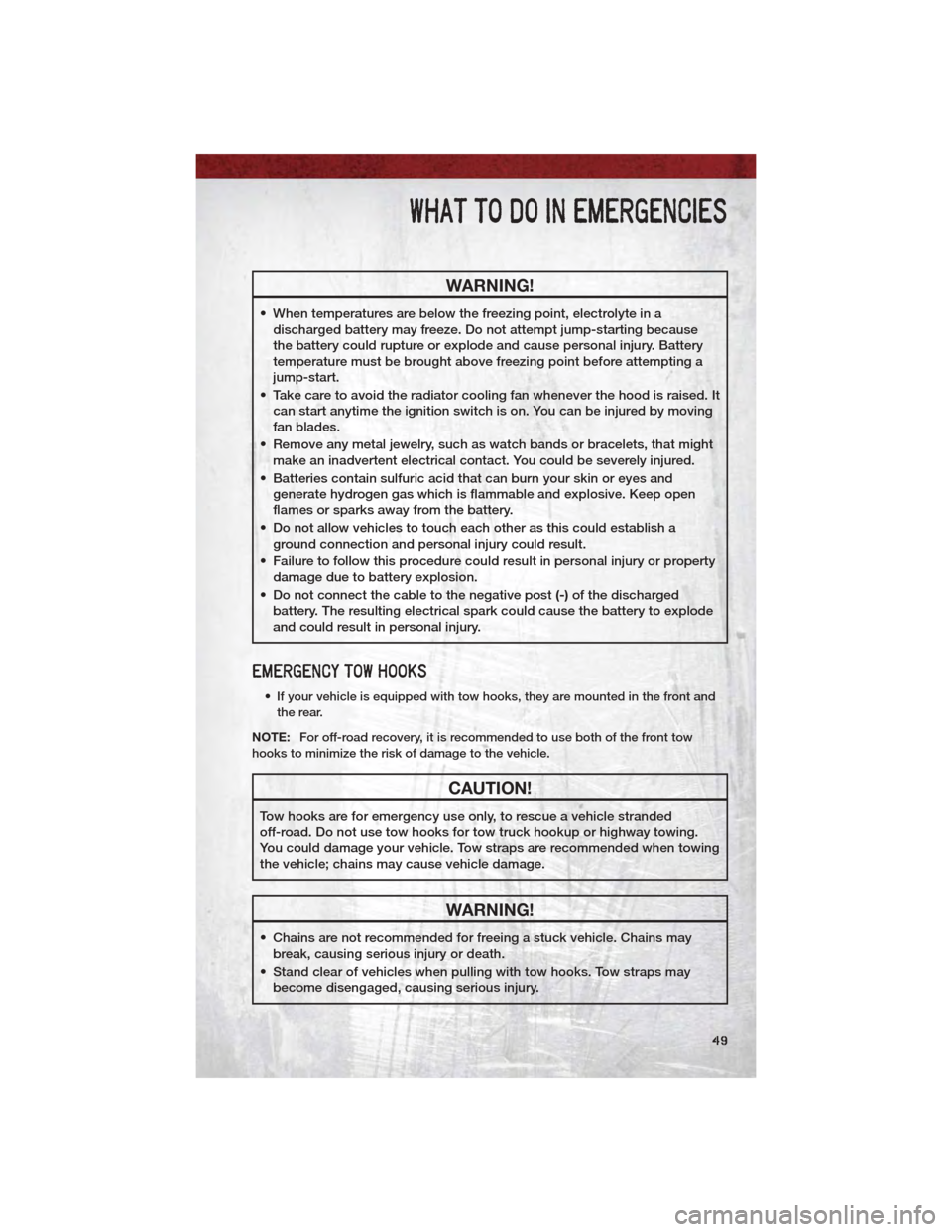
WARNING!
• When temperatures are below the freezing point, electrolyte in adischarged battery may freeze. Do not attempt jump-starting because
the battery could rupture or explode and cause personal injury. Battery
temperature must be brought above freezing point before attempting a
jump-start.
• Take care to avoid the radiator cooling fan whenever the hood is raised. It can start anytime the ignition switch is on. You can be injured by moving
fan blades.
• Remove any metal jewelry, such as watch bands or bracelets, that might make an inadvertent electrical contact. You could be severely injured.
• Batteries contain sulfuric acid that can burn your skin or eyes and generate hydrogen gas which is flammable and explosive. Keep open
flames or sparks away from the battery.
• Do not allow vehicles to touch each other as this could establish a ground connection and personal injury could result.
• Failure to follow this procedure could result in personal injury or property damage due to battery explosion.
• Do not connect the cable to the negative post (-)of the discharged
battery. The resulting electrical spark could cause the battery to explode
and could result in personal injury.
EMERGENCY TOW HOOKS
• If your vehicle is equipped with tow hooks, they are mounted in the front and
the rear.
NOTE: For off-road recovery, it is recommended to use both of the front tow
hooks to minimize the risk of damage to the vehicle.
CAUTION!
Tow hooks are for emergency use only, to rescue a vehicle stranded
off-road. Do not use tow hooks for tow truck hookup or highway towing.
You could damage your vehicle. Tow straps are recommended when towing
the vehicle; chains may cause vehicle damage.
WARNING!
• Chains are not recommended for freeing a stuck vehicle. Chains may break, causing serious injury or death.
• Stand clear of vehicles when pulling with tow hooks. Tow straps may become disengaged, causing serious injury.
WHAT TO DO IN EMERGENCIES
49
Page 52 of 76
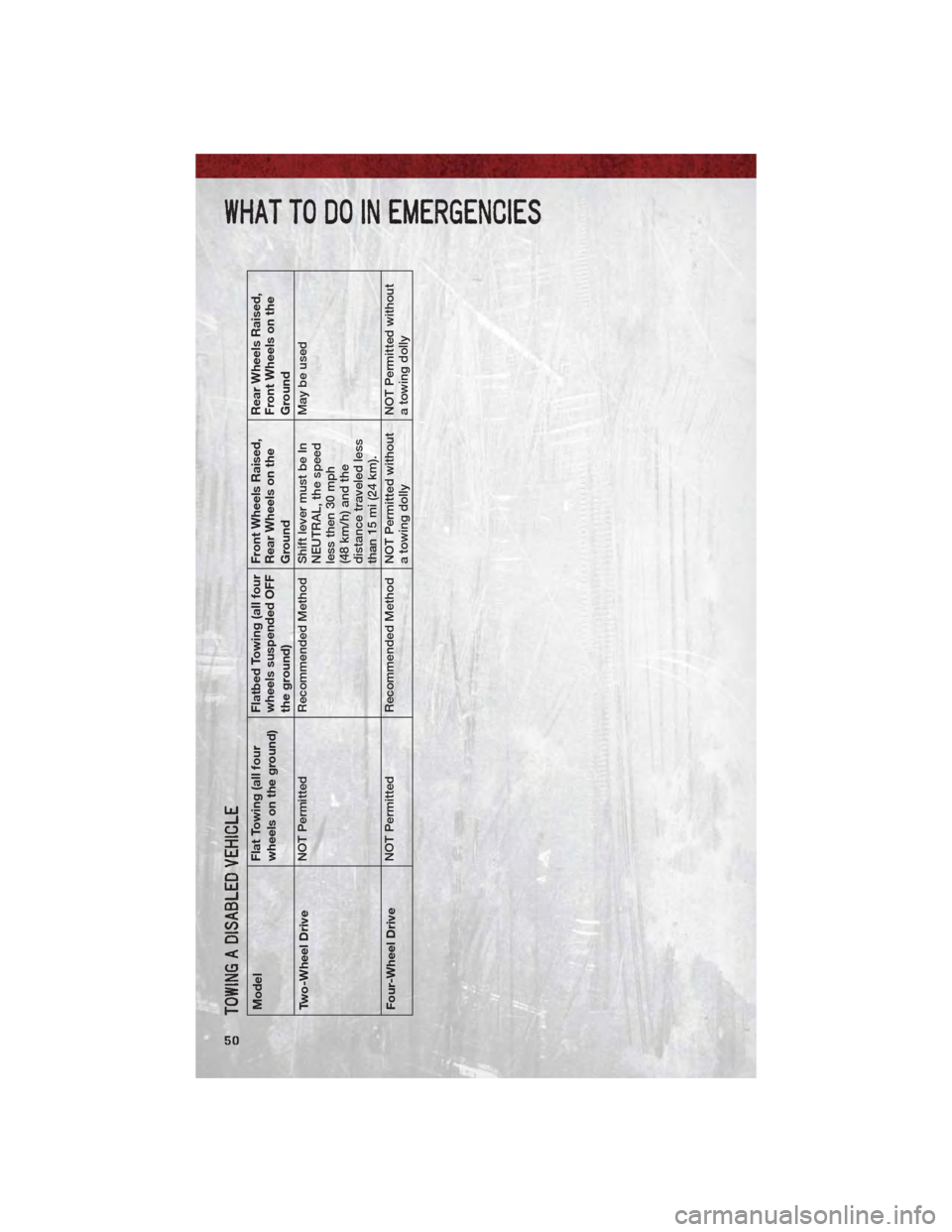
TOWING A DISABLED VEHICLEModelFlat Towing (all four
wheels on the ground)Flatbed Towing (all four
wheels suspended OFF
the ground)Front Wheels Raised,
Rear Wheels on the
GroundRear Wheels Raised,
Front Wheels on the
Ground
Two-Wheel Drive NOT Permitted
Recommended Method Shift lever must be In
NEUTRAL, the speed
less then 30 mph
(48 km/h) and the
distance traveled less
than 15 mi (24 km).May be used
Four-Wheel Drive NOT Permitted
Recommended Method NOT Permitted without
a towing dollyNOT Permitted without
a towing dolly
WHAT TO DO IN EMERGENCIES
50
Page 53 of 76
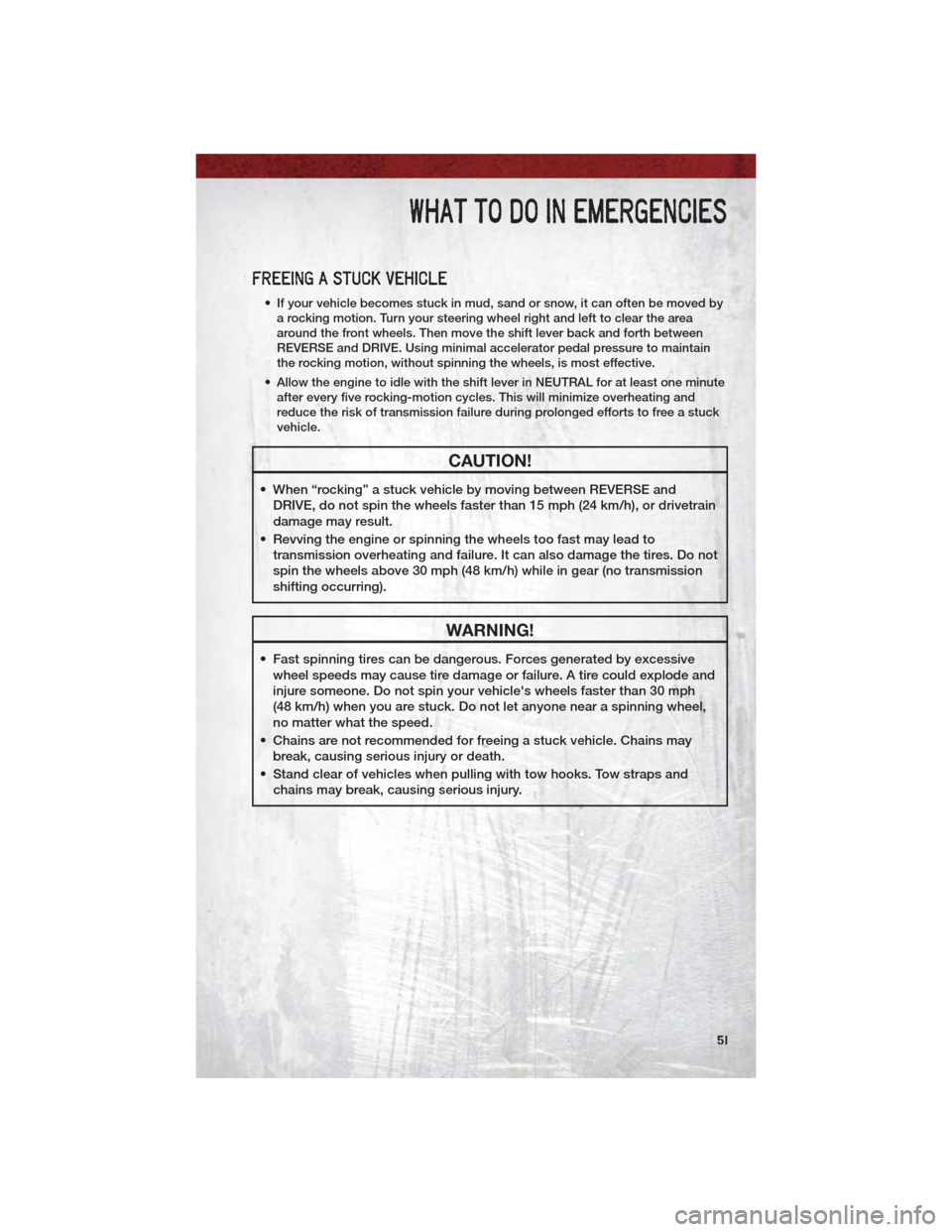
FREEING A STUCK VEHICLE
• If your vehicle becomes stuck in mud, sand or snow, it can often be moved bya rocking motion. Turn your steering wheel right and left to clear the area
around the front wheels. Then move the shift lever back and forth between
REVERSE and DRIVE. Using minimal accelerator pedal pressure to maintain
the rocking motion, without spinning the wheels, is most effective.
• Allow the engine to idle with the shift lever in NEUTRAL for at least one minute after every five rocking-motion cycles. This will minimize overheating and
reduce the risk of transmission failure during prolonged efforts to free a stuck
vehicle.
CAUTION!
• When “rocking” a stuck vehicle by moving between REVERSE andDRIVE, do not spin the wheels faster than 15 mph (24 km/h), or drivetrain
damage may result.
• Revving the engine or spinning the wheels too fast may lead to transmission overheating and failure. It can also damage the tires. Do not
spin the wheels above 30 mph (48 km/h) while in gear (no transmission
shifting occurring).
WARNING!
• Fast spinning tires can be dangerous. Forces generated by excessivewheel speeds may cause tire damage or failure. A tire could explode and
injure someone. Do not spin your vehicle's wheels faster than 30 mph
(48 km/h) when you are stuck. Do not let anyone near a spinning wheel,
no matter what the speed.
• Chains are not recommended for freeing a stuck vehicle. Chains may break, causing serious injury or death.
• Stand clear of vehicles when pulling with tow hooks. Tow straps and chains may break, causing serious injury.
WHAT TO DO IN EMERGENCIES
51
Page 54 of 76
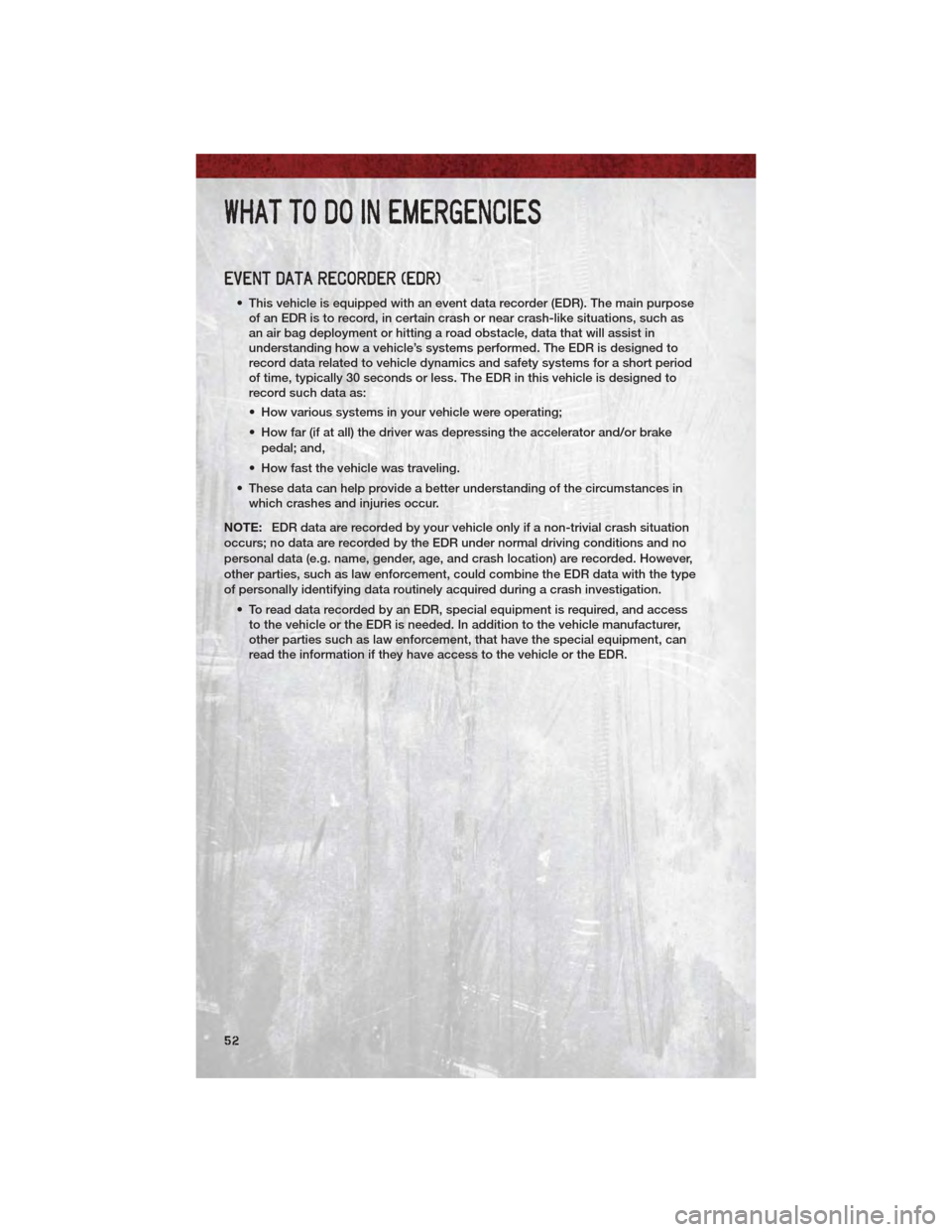
EVENT DATA RECORDER (EDR)
• This vehicle is equipped with an event data recorder (EDR). The main purposeof an EDR is to record, in certain crash or near crash-like situations, such as
an air bag deployment or hitting a road obstacle, data that will assist in
understanding how a vehicle’s systems performed. The EDR is designed to
record data related to vehicle dynamics and safety systems for a short period
of time, typically 30 seconds or less. The EDR in this vehicle is designed to
record such data as:
• How various systems in your vehicle were operating;
• How far (if at all) the driver was depressing the accelerator and/or brake
pedal; and,
• How fast the vehicle was traveling.
• These data can help provide a better understanding of the circumstances in which crashes and injuries occur.
NOTE: EDR data are recorded by your vehicle only if a non-trivial crash situation
occurs; no data are recorded by the EDR under normal driving conditions and no
personal data (e.g. name, gender, age, and crash location) are recorded. However,
other parties, such as law enforcement, could combine the EDR data with the type
of personally identifying data routinely acquired during a crash investigation.
• To read data recorded by an EDR, special equipment is required, and accessto the vehicle or the EDR is needed. In addition to the vehicle manufacturer,
other parties such as law enforcement, that have the special equipment, can
read the information if they have access to the vehicle or the EDR.
WHAT TO DO IN EMERGENCIES
52
Page 55 of 76
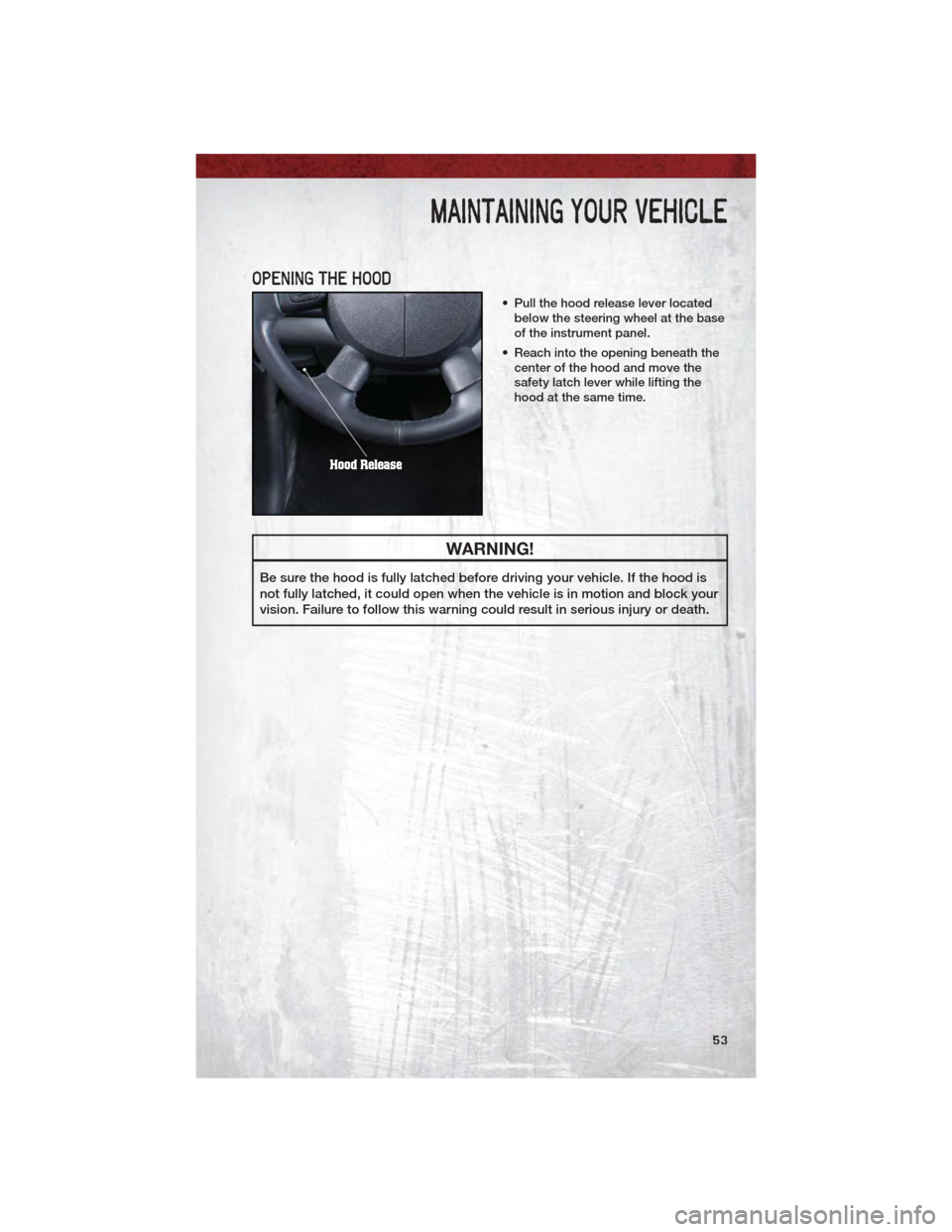
OPENING THE HOOD
• Pull the hood release lever locatedbelow the steering wheel at the base
of the instrument panel.
• Reach into the opening beneath the center of the hood and move the
safety latch lever while lifting the
hood at the same time.
WARNING!
Be sure the hood is fully latched before driving your vehicle. If the hood is
not fully latched, it could open when the vehicle is in motion and block your
vision. Failure to follow this warning could result in serious injury or death.
MAINTAINING YOUR VEHICLE
53
Page 56 of 76
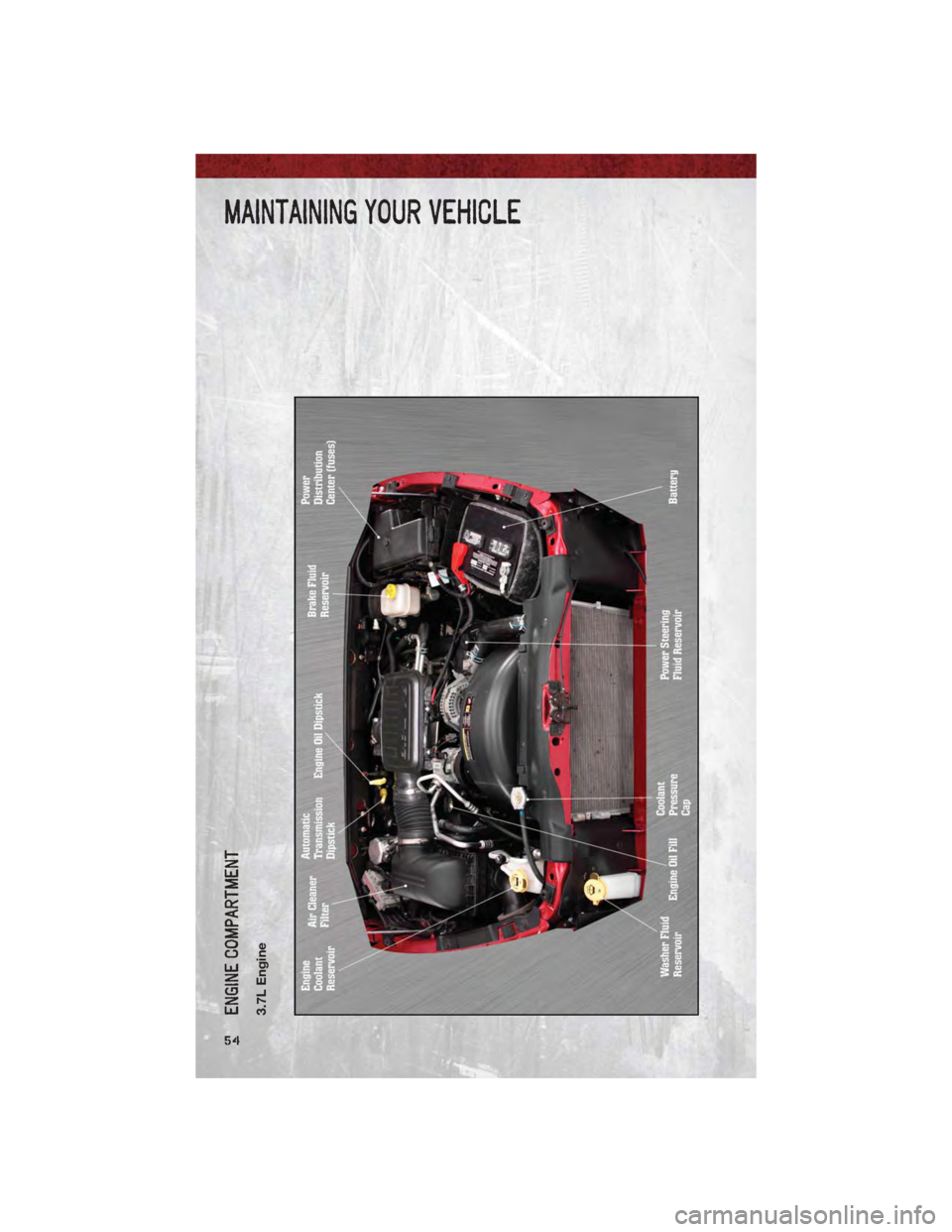
ENGINE COMPARTMENT3.7L Engine
MAINTAINING YOUR VEHICLE
54
Page 57 of 76
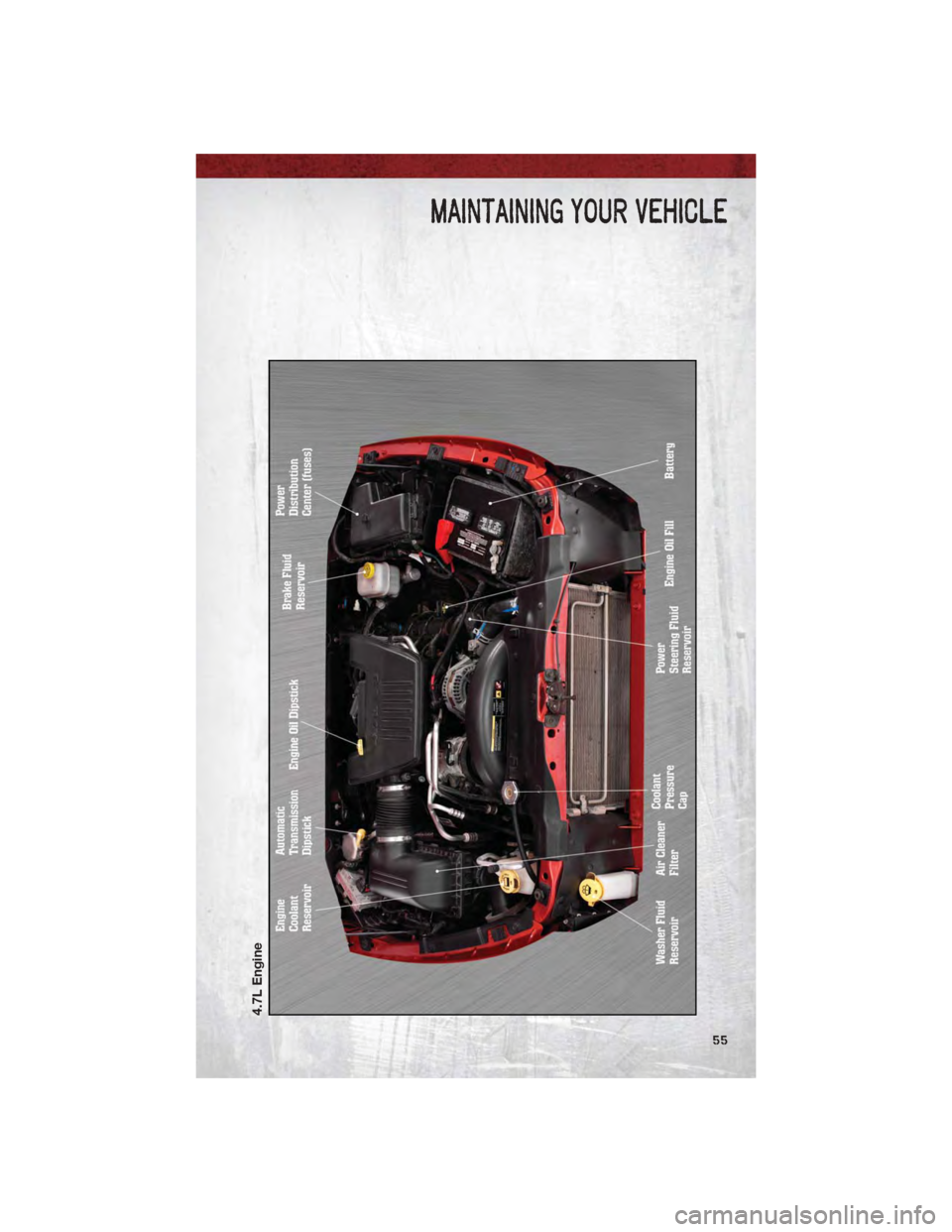
4.7L Engine
MAINTAINING YOUR VEHICLE
55
Page 58 of 76
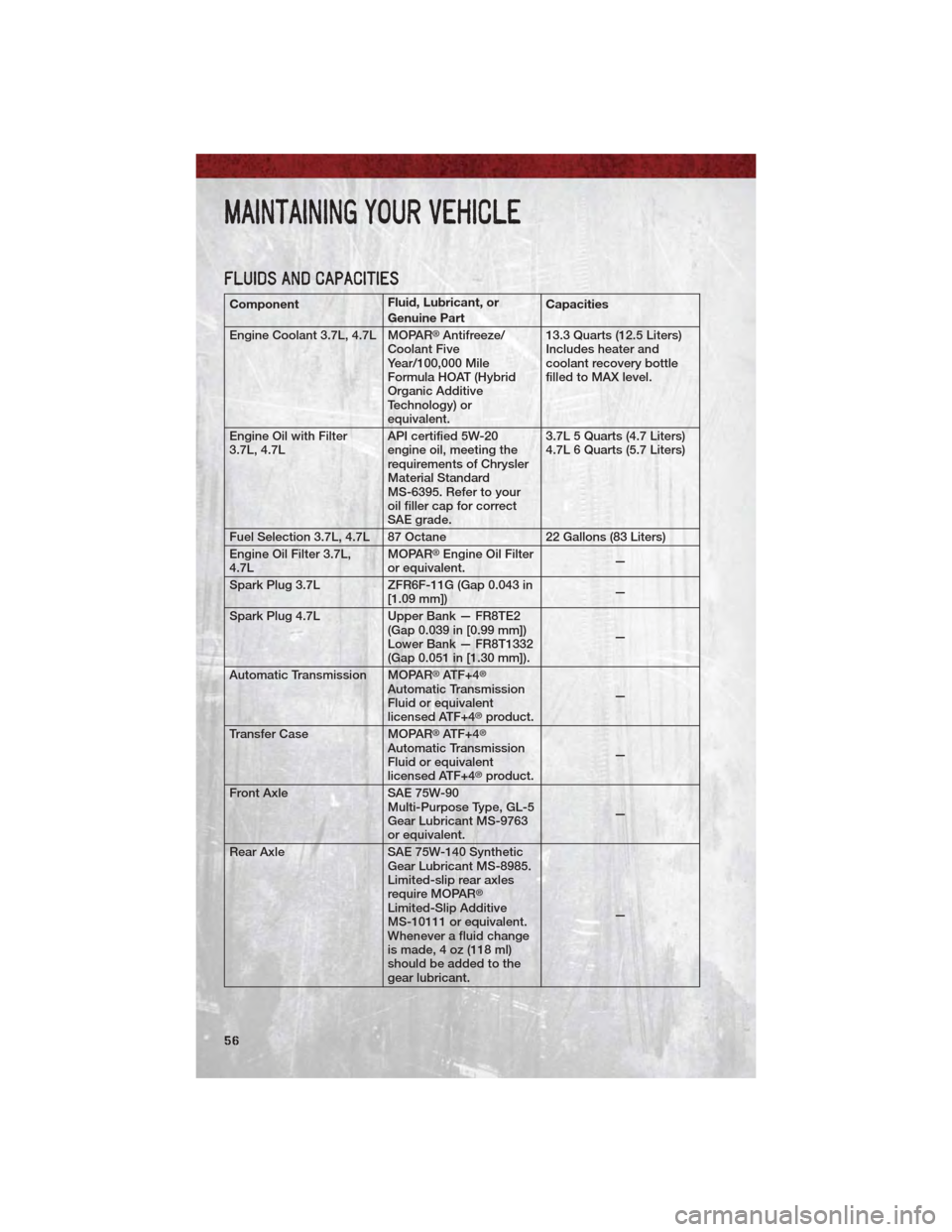
FLUIDS AND CAPACITIES
ComponentFluid, Lubricant, or
Genuine PartCapacities
Engine Coolant 3.7L, 4.7L MOPAR
®Antifreeze/
Coolant Five
Year/100,000 Mile
Formula HOAT (Hybrid
Organic Additive
Technology) or
equivalent. 13.3 Quarts (12.5 Liters)
Includes heater and
coolant recovery bottle
filled to MAX level.
Engine Oil with Filter
3.7L, 4.7L API certified 5W-20
engine oil, meeting the
requirements of Chrysler
Material Standard
MS-6395. Refer to your
oil filler cap for correct
SAE grade.3.7L 5 Quarts (4.7 Liters)
4.7L 6 Quarts (5.7 Liters)
Fuel Selection 3.7L, 4.7L 87 Octane 22 Gallons (83 Liters)
Engine Oil Filter 3.7L,
4.7L MOPAR
®Engine Oil Filter
or equivalent. —
Spark Plug 3.7L ZFR6F-11G (Gap 0.043 in
[1.09 mm]) —
Spark Plug 4.7L Upper Bank — FR8TE2
(Gap 0.039 in [0.99 mm])
Lower Bank — FR8T1332
(Gap 0.051 in [1.30 mm]). —
Automatic Transmission MOPAR
®ATF+4®
Automatic Transmission
Fluid or equivalent
licensed ATF+4
®product. —
Transfer Case MOPAR®ATF+4®
Automatic Transmission
Fluid or equivalent
licensed ATF+4
®product. —
Front Axle SAE 75W-90 Multi-Purpose Type, GL-5
Gear Lubricant MS-9763
or equivalent. —
Rear Axle SAE 75W-140 Synthetic Gear Lubricant MS-8985.
Limited-slip rear axles
require MOPAR
®
Limited-Slip Additive
MS-10111 or equivalent.
Whenever a fluid change
is made, 4 oz (118 ml)
should be added to the
gear lubricant. —
MAINTAINING YOUR VEHICLE
56
Page 59 of 76
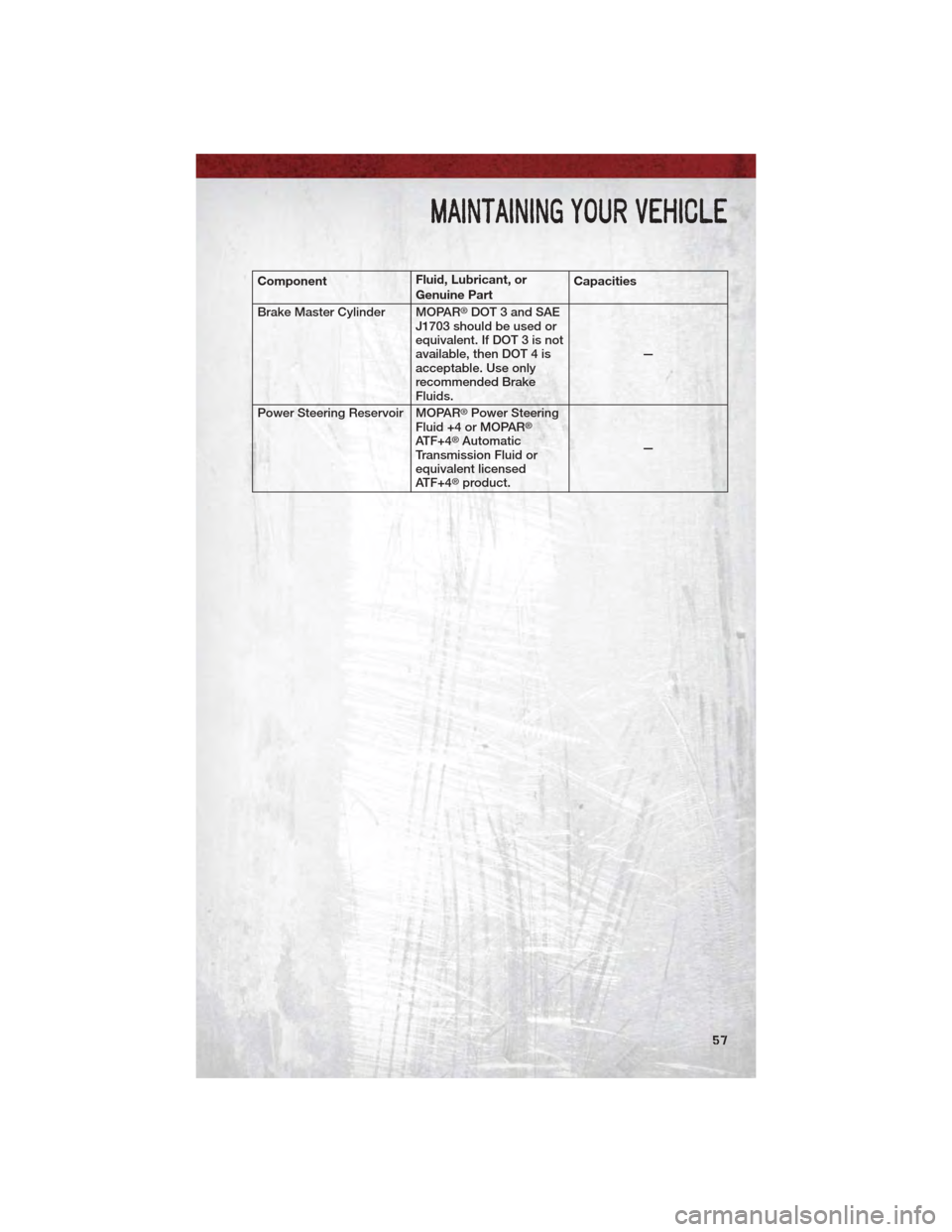
ComponentFluid, Lubricant, or
Genuine PartCapacities
Brake Master Cylinder MOPAR
®DOT 3 and SAE
J1703 should be used or
equivalent. If DOT 3 is not
available, then DOT 4 is
acceptable. Use only
recommended Brake
Fluids. —
Power Steering Reservoir MOPAR
®Power Steering
Fluid +4 or MOPAR®
ATF+4®Automatic
Transmission Fluid or
equivalent licensed
ATF+4
®product. —
MAINTAINING YOUR VEHICLE
57
Page 60 of 76
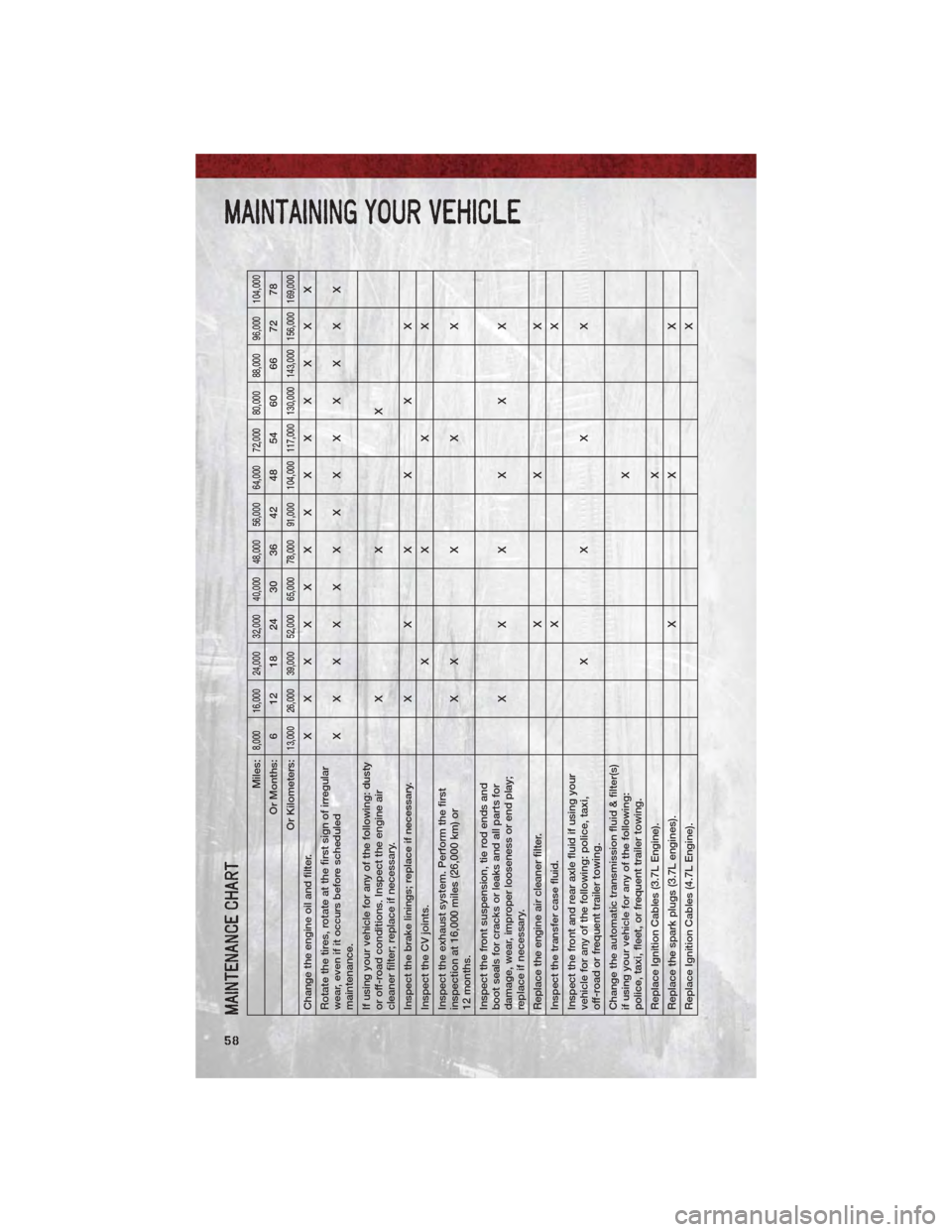
MAINTENANCE CHART
Miles:
8,000 16,000 24,000 32,000 40,000 48,000 56,000 64,000 72,000 80,000 88,000 96,000 104,000
Or Months: 6 12 18 24 30 36 42 48 54 60 66 72 78
Or Kilometers:
13,000 26,000 39,000 52,000 65,000 78,000 91,000 104,000 117,000 130,000 143,000 156,000 169,000
Change the engine oil and filter. XXXXXXXXXXXXX
Rotate the tires, rotate at the first sign of irregular
wear, even if it occurs before scheduled
maintenance. XXXXXXXXXXXXX
If using your vehicle for any of the following: dusty
or off-road conditions. Inspect the engine air
cleaner filter; replace if necessary. XXX
Inspect the brake linings; replace if necessary. X X X X X X
Inspect the CV joints. XXXX
Inspect the exhaust system. Perform the first
inspection at 16,000 miles (26,000 km) or
12 months. XXXXX
Inspect the front suspension, tie rod ends and
boot seals for cracks or leaks and all parts for
damage, wear, improper looseness or end play;
replace if necessary. XXXXXX
Replace the engine air cleaner filter. XXX
Inspect the transfer case fluid. XX
Inspect the front and rear axle fluid if using your
vehicle for any of the following: police, taxi,
off-road or frequent trailer towing. XXXX
Change the automatic transmission fluid & filter(s)
if using your vehicle for any of the following:
police, taxi, fleet, or frequent trailer towing. X
Replace Ignition Cables (3.7L Engine). X
Replace the spark plugs (3.7L engines). XXX
Replace Ignition Cables (4.7L Engine). X
MAINTAINING YOUR VEHICLE
58